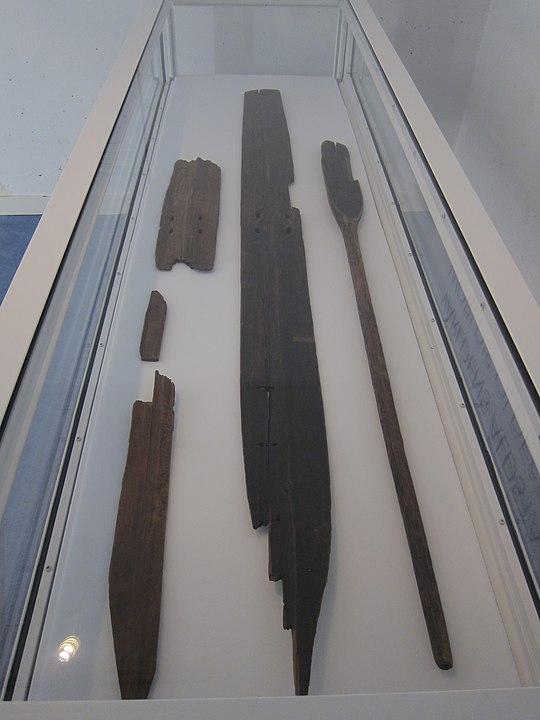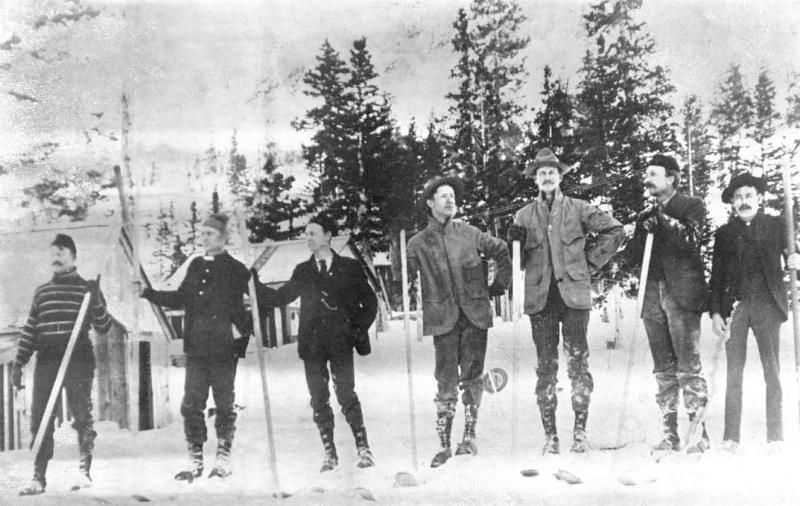History of Ski Equipment
By Matthew J Glowacki
The Ski industry in Utah is as big as ever with companies like Rossingol, Salomon and Kuhl, setting up headquarters in and around the Salt Lake Area. But not many people know how the modern day ski scene came to be. In this section I will be highlighting how skis transformed from an ancient form of transportation into the billion dollar tourism industry it is today.
 The first record of skis goes back Twenty-two thousand years to the Paleolithic Ice age. Meaning skis were invented before the wheel (Created Twelve Thousand Years ago). Cave drawings suggest that the people of this time used Snowshoes/skis to cross frozen wetlands. Meaning that skiing wasn't invented for recreation but instead made for easy transportation over frozen ground. They also used the skis to hunt as it would make hauling the animals back much easier and quicker. The skis at this point didn't resemble a modern day ski at all. The skis consisted of two planks of wood that were about 7 feet long with animal hide strapped to the bottom. Even though these types of skis were widely used throughout Europe and central Asia, it was mostly cross country skiing. The materials also used to create the skis were very primal and would not be able to withstand downhill skiing.
The first record of skis goes back Twenty-two thousand years to the Paleolithic Ice age. Meaning skis were invented before the wheel (Created Twelve Thousand Years ago). Cave drawings suggest that the people of this time used Snowshoes/skis to cross frozen wetlands. Meaning that skiing wasn't invented for recreation but instead made for easy transportation over frozen ground. They also used the skis to hunt as it would make hauling the animals back much easier and quicker. The skis at this point didn't resemble a modern day ski at all. The skis consisted of two planks of wood that were about 7 feet long with animal hide strapped to the bottom. Even though these types of skis were widely used throughout Europe and central Asia, it was mostly cross country skiing. The materials also used to create the skis were very primal and would not be able to withstand downhill skiing.
 The next change in ski equipment doesn't come around till the eighteenth century in Scandinavia. The reason for change was to help transport soldiers down the mountain side into attacking positions on the ground below. These skis still appeared very primitive but had significant changes compared to the original skis. The difference being that these new skis had bindings that allowed you to be clipped in to your skis giving you more control. The skis however were still made of heavy and long wood that could sometimes be 115 centimeters in length. Along with bindings these new skis also warped at the end creating edges on the skis giving the ability to turn while skiing downhill. Leading to the discovery of downhill skiing and thus began the creation of alpine skis. The Armies using skis as transportation began to discover the excitement in downhill skiing and started competitions between regiments. These competitions began to catch the eyes of the public and soon these friendly competitions became heated races. By the eighteen forties skiing had grown in popularity so much that the first public skiing competitions began in Norway. Around this time as well skiing began to make its way to America and establish itself within its culture there. The first signs of skiing in the Wasatch are from the miners using it to get too and from work. Skis were also used to deliver mail in Utah during its early years. Soon Skiing blew up the Wasatch with resorts like Brighton opening up in Nineteen Thirty-Six. Not long after skis began to change dramatically year by year as the industry for skis changed from transportation to recreation. Skis began to get lighter and stronger by using lighter woods like Hickory and laminating them for durability.
The next change in ski equipment doesn't come around till the eighteenth century in Scandinavia. The reason for change was to help transport soldiers down the mountain side into attacking positions on the ground below. These skis still appeared very primitive but had significant changes compared to the original skis. The difference being that these new skis had bindings that allowed you to be clipped in to your skis giving you more control. The skis however were still made of heavy and long wood that could sometimes be 115 centimeters in length. Along with bindings these new skis also warped at the end creating edges on the skis giving the ability to turn while skiing downhill. Leading to the discovery of downhill skiing and thus began the creation of alpine skis. The Armies using skis as transportation began to discover the excitement in downhill skiing and started competitions between regiments. These competitions began to catch the eyes of the public and soon these friendly competitions became heated races. By the eighteen forties skiing had grown in popularity so much that the first public skiing competitions began in Norway. Around this time as well skiing began to make its way to America and establish itself within its culture there. The first signs of skiing in the Wasatch are from the miners using it to get too and from work. Skis were also used to deliver mail in Utah during its early years. Soon Skiing blew up the Wasatch with resorts like Brighton opening up in Nineteen Thirty-Six. Not long after skis began to change dramatically year by year as the industry for skis changed from transportation to recreation. Skis began to get lighter and stronger by using lighter woods like Hickory and laminating them for durability.

Skis were made of entirely wood besides the bindings up until the nineteen fifties when the material switched to a plywood core with an aluminum top and plastic side walls. The skis began to be made of multiple materiales instead of one plank of wood. Once this began, the search to make the strongest and lightest ski began. Thus leading into modern day skis that you can find being made by any Utah ski company. These modern day skis consist of fiberglass and different carbon molds. As skiing grows in popularity so will the equipment industry as more and more companies try to make Utah their headquarters. Truly remarkable to see such a quick change in ski equipment in such a short time. However it is interesting to see how skis nowadays are so advanced in comparison to the primitive skis of the Paleolithic Ice Age.
Image Sources:
Kalvträskskidan Ski Artifacts from Västerbottens Museum Västerbottens Museum; Umea, Sweden https://en.wikipedia.org/wiki/History_of_skiing#/media/File:Skidmuseet_(02).jpg
Miners getting ready to leave for work
Aspen Historical Society
https://www.aspenjournalism.org/2017/01/11/aspen-ski-history-timeline/
Professional Skier Hitting a Jump in Top of the Line Gear
https://www.skipeak.net/blog/the-modern-day-ski-lingo-language
Matthew J Glowacki
 I was born and raised in Chicago, Illinois. My favorite part about this Block U class is the materials we have studied throughout the semester. My favorite topic being the 7 dimensions of wellness. Studying this helped me learn how to deal with my stress and pick up new habits that help me live healthier. For example you can meditate every couple of days to help grow your spiritual dimension. I want to study either Sociology or Psychology.
I was born and raised in Chicago, Illinois. My favorite part about this Block U class is the materials we have studied throughout the semester. My favorite topic being the 7 dimensions of wellness. Studying this helped me learn how to deal with my stress and pick up new habits that help me live healthier. For example you can meditate every couple of days to help grow your spiritual dimension. I want to study either Sociology or Psychology.
